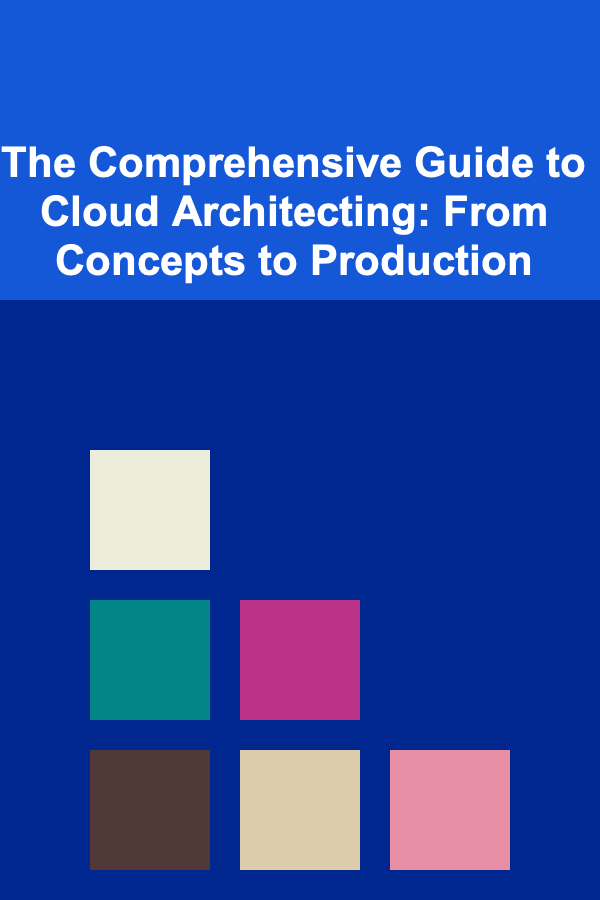
The Comprehensive Guide to Cloud Architecting: From Concepts to Production
ebook include PDF & Audio bundle (Micro Guide)
$12.99$6.99
Limited Time Offer! Order within the next:

Cloud architecture is the backbone of modern IT infrastructure, enabling businesses to leverage the benefits of cloud computing to scale, innovate, and optimize their operations. From foundational concepts to real-world deployment in production, cloud architecting requires a deep understanding of cloud services, design principles, and best practices. This guide provides an in-depth exploration of cloud architecture, offering actionable insights and strategies for building robust, scalable, and efficient cloud systems.
Understanding the Basics of Cloud Architecture
Before diving into the technicalities, it's essential to establish a solid understanding of cloud architecture and its components. Cloud architecture refers to the design and structure of IT systems that are hosted on cloud platforms. These systems can range from simple applications to complex multi-tier enterprise solutions.
Key Cloud Computing Models:
- Infrastructure as a Service (IaaS): Provides virtualized computing resources over the internet. It includes compute power, storage, and networking, allowing organizations to build their own infrastructure without the need for physical hardware.
- Platform as a Service (PaaS): Provides a platform that allows developers to build, run, and manage applications without worrying about underlying infrastructure. Examples include services like Google App Engine or Microsoft Azure App Services.
- Software as a Service (SaaS): Refers to applications delivered over the internet, where users access the software via a web browser without needing to install or maintain it. Popular examples include Gmail, Slack, and Salesforce.
Cloud Deployment Models:
- Public Cloud: Cloud resources are owned and operated by third-party cloud service providers and made available to the public.
- Private Cloud: Cloud resources are used exclusively by one organization, either hosted internally or by a third-party provider.
- Hybrid Cloud: A combination of both public and private clouds, allowing data and applications to be shared between them.
Understanding these foundational models is essential for designing an architecture that aligns with your business needs, scalability requirements, and security considerations.
Key Principles of Cloud Architecture
Cloud architecture is driven by several core principles that help ensure the scalability, flexibility, and reliability of your applications. These principles guide architects in creating systems that can handle varying loads, recover from failures, and adapt to future changes.
1. Scalability
Scalability refers to the system's ability to handle increased traffic or data volume by adding more resources, such as compute power, storage, or networking capacity. There are two primary types of scalability:
- Vertical Scaling (Scaling Up): Adding more power (CPU, memory) to an existing server.
- Horizontal Scaling (Scaling Out): Adding more servers or instances to distribute the load.
In cloud architecture, horizontal scaling is more common due to its flexibility and cost-efficiency. Services like AWS Auto Scaling or Google Cloud's Compute Engine allow for automatic scaling based on real-time demand.
2. High Availability
Cloud systems are often designed for high availability, ensuring that services remain operational even during hardware failures or network issues. This is achieved through redundancy, load balancing, and failover mechanisms. For instance, using multiple availability zones (AZs) in AWS or Google Cloud ensures that if one zone experiences issues, the system can failover to another without disrupting services.
3. Fault Tolerance
Fault tolerance refers to a system's ability to continue operating even when part of the system fails. This is essential in cloud environments, where components can fail unexpectedly. Techniques like data replication (across regions or availability zones), distributed databases, and microservices architectures can help achieve fault tolerance.
4. Security and Compliance
Security is one of the most critical aspects of cloud architecture. Data should be encrypted in transit and at rest, access should be controlled using identity and access management (IAM), and services should be regularly audited for compliance with standards like GDPR, HIPAA, and SOC 2. Encryption, firewalls, and security monitoring tools are essential components in building secure cloud architectures.
5. Cost Efficiency
Cloud architecture should also be designed with cost efficiency in mind. Cloud providers offer pay-as-you-go pricing models, meaning you only pay for the resources you consume. However, without proper management, costs can quickly spiral. Cloud architects should optimize resource allocation, choose the right pricing models (on-demand, reserved instances, spot instances), and automate resource scaling to manage costs effectively.
Cloud Architecture Design Process
Designing cloud architecture involves several steps that require careful consideration of both technical and business requirements. Below is a high-level overview of the design process.
Step 1: Define Business Requirements
The first step is to understand the goals and requirements of the business. This includes:
- Application requirements: What does the application do? What are the critical performance indicators (KPIs)?
- User load: How many users are expected, and what are the peak usage patterns?
- Data storage: What type of data needs to be stored (structured, unstructured, transactional, or analytical)?
- Security requirements: What are the compliance and security requirements?
- Cost constraints: What is the budget for the cloud solution?
Step 2: Choose the Right Cloud Provider
Based on the requirements, the next step is selecting the cloud provider that best fits the needs of the business. The most popular cloud providers are:
- Amazon Web Services (AWS)
- Microsoft Azure
- Google Cloud Platform (GCP)
Consider factors such as pricing, available services, global reach, and compliance certifications when choosing the provider.
Step 3: Design the Cloud Architecture
With the business requirements in mind, it's time to design the cloud architecture. The design should include the following elements:
- Compute: Choose between virtual machines, containers, or serverless computing based on the application needs.
- Storage: Decide on the appropriate storage solution (block storage, object storage, databases) based on the type of data and access patterns.
- Networking: Plan for networking components like Virtual Private Networks (VPNs), load balancers, and firewalls to manage traffic securely and efficiently.
- Identity and Access Management (IAM): Implement IAM policies to ensure proper access control.
- Monitoring and Logging: Incorporate tools for real-time monitoring (e.g., CloudWatch, Stackdriver) and logging (e.g., CloudTrail, Stackdriver Logging) to track system performance and troubleshoot issues.
Step 4: Implementing and Testing the Architecture
After the design phase, it's time to implement the solution. This step involves configuring cloud resources, deploying services, and ensuring that everything works as expected.
- Automation: Use Infrastructure as Code (IaC) tools like Terraform or AWS CloudFormation to automate the provisioning of cloud resources.
- Testing: Before launching in production, perform extensive testing, including load testing, security testing, and disaster recovery testing.
Step 5: Launch and Continuous Improvement
Once the system is tested, it's ready to go live. However, cloud architecture is not a one-time effort. Continuous monitoring, optimization, and iteration are required to maintain and improve the architecture over time.
- Performance Tuning: Regularly analyze system performance and optimize resource usage.
- Security Audits: Continuously audit for vulnerabilities and ensure compliance.
- Cost Management: Use tools like AWS Cost Explorer or GCP's cost management dashboard to track expenses and ensure cost optimization.
Advanced Topics in Cloud Architecture
Once the basic architecture is in place, cloud architects often dive into advanced topics to further optimize systems for scalability, reliability, and cost-effectiveness.
Microservices Architecture
Microservices involve breaking down applications into smaller, independent services that can be deployed, scaled, and maintained independently. This architecture allows for better flexibility and fault isolation. Containerization technologies like Docker and Kubernetes play a critical role in deploying microservices at scale.
Serverless Architectures
Serverless computing abstracts the underlying infrastructure away from the developer. AWS Lambda, Azure Functions, and Google Cloud Functions allow developers to run code without managing servers. This architecture is ideal for event-driven applications and can significantly reduce operational overhead.
Multi-Cloud Architectures
Some organizations prefer to use multiple cloud providers for redundancy, risk mitigation, or to leverage the strengths of different platforms. A multi-cloud architecture can increase availability but also adds complexity in terms of management, integration, and cost monitoring.
Cloud-Native Design Patterns
Cloud-native design refers to building applications that fully leverage cloud environments. It involves using patterns such as caching , event-driven architectures , and service discovery to optimize cloud applications for resilience, performance, and scalability.
Conclusion
Cloud architecture is a complex yet essential field for modern businesses, enabling them to build scalable, secure, and cost-effective systems. From understanding the core principles of cloud design to implementing and optimizing systems in production, cloud architects must constantly evolve their skills to stay ahead of emerging technologies and best practices.
The key to success in cloud architecting lies in a clear understanding of business needs, selecting the right cloud services, and continuously optimizing the architecture. With these principles in mind, cloud architects can create robust systems that not only meet current demands but are also prepared for future growth and change.

How to Incorporate Smart Storage into Budget-Friendly Decor
Read More
How to Keep Track of Your Fitness Equipment Inventory
Read More
How to Use Podcast Editing Skills to Make Money
Read More
Mastering Client Relations: Strategies for the Modern Client Relations Manager
Read More
How To Pick the Perfect Romance Novel for Your Mood
Read More
How to Conduct a Talent Acquisition Plan Audit and Improve Results
Read MoreOther Products

How to Incorporate Smart Storage into Budget-Friendly Decor
Read More
How to Keep Track of Your Fitness Equipment Inventory
Read More
How to Use Podcast Editing Skills to Make Money
Read More
Mastering Client Relations: Strategies for the Modern Client Relations Manager
Read More
How To Pick the Perfect Romance Novel for Your Mood
Read More